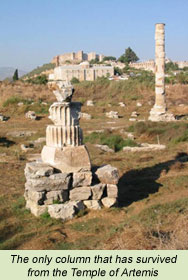Although the foundation of the temple dates back to the seventh century B.C., the structure that earned a spot in the list of Wonders was built around 550 B.C. Referred to as the great marble temple, it was sponsored by the Lydian king Croesus and was designed by the Greek architect Chersiphron. The Temple was decorated with bronze statues sculpted by the most skilled artists of their time: Pheidias, Polycleitus, Kresilas, and Phradmon.
The temple served as both a marketplace and a religious institution. For years, the sanctuary was visited by merchants, tourists, artisans, and kings who paid homage to the goddess by sharing their profits with her. Recent archaeological excavations at the site revealed gifts from pilgrims including statuettes of Artemis made of gold and ivory... earrings, bracelets, and necklaces... artifacts from as far as Persia and India.

On the night of 21 July 356 B.C., a man named Herostratus burned the temple to ground in an attempt to immortalize his name, which he did indeed. Oddly enough, Alexander the Great was born the same night. The historian Plutarch later wrote that the goddess was "too busy taking care of the birth of Alexander to send help to her threatened temple". And when Alexander the Great conquered Asia Minor, he offered to rebuild the destroyed temple, but the the reconstruction of the temple was not finished until his death in 323 B.C.
When St. Paul visited Ephesus to preach Christianity in the first century A.D., he was confronted by the Artemis’ cult who had no plans to abandon their goddess. And when the temple was again destroyed by the Goths in 262 A.D., the Ephesians vowed to rebuild. By the fourth century A.D., most Ephesians had converted to Christianity and the temple lost its religious glamor. The final chapter came when in 401 A.D. the Temple of Artemis was torn down by St. John Chrysostom. Ephesus was later deserted, and only in the late nineteenth century has the site been excavated. The digging revealed the temple's foundation and the road to the now swampy site. Attempts were recently made to rebuilt the temple, but only a few columns have been re-erected.
Description of the TempleThe foundation of the temple was rectangular in form, similar to most temples at the time. Unlike other sanctuaries, however, the building was made of marble, with a decorated façade overlooking a spacious courtyard. Marble steps surrounding the building platform led to the high terrace which was approximately 80 m (260 ft) by 130 m (430 ft) in plan. The columns were 20 m (60 ft) high with Ionic capitals and carved circular sides. There were 127 columns in total, aligned orthogonally over the whole platform area, except for the central cella or house of the goddess.
The temple housed many works of art, including four ancient bronze statues of Amazons sculpted by the finest artists at the time. When St. Paul visited the city, the temple was adorned with golden pillars and silver statuettes, and was decorated with paintings. There is no evidence that a statue of the goddess herself was placed at the center of the sanctuary, but there is no reason not to believe so.
The early detailed descriptions of the temple helped archaeologists reconstruct the building. Many reconstructions such as that by H.F. von Erlach depicted the façade with a four-column porch which never existed. More accurate reconstructions may give us an idea about the general layout of the temple. However, its true beauty lies in the architectural and artistic details which will forever remain unknown.

